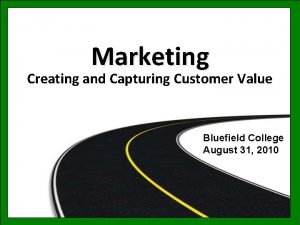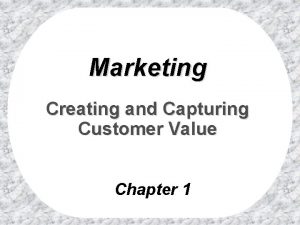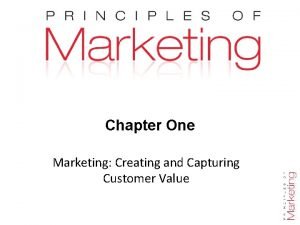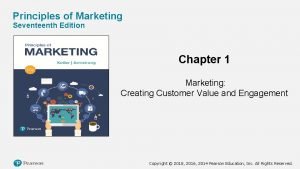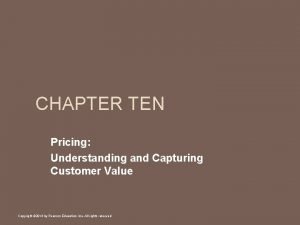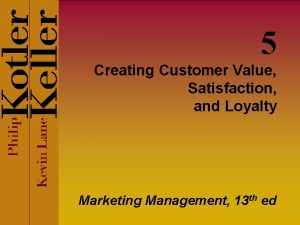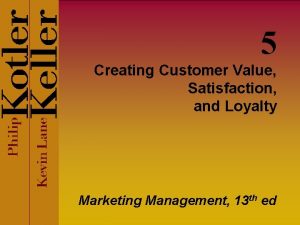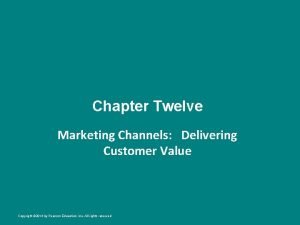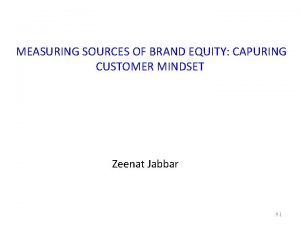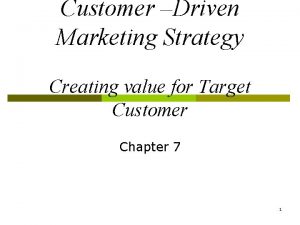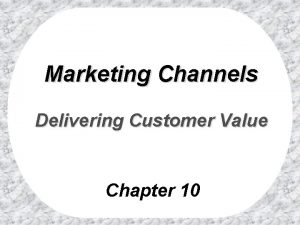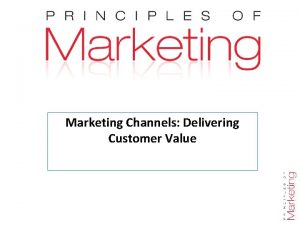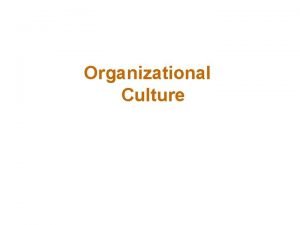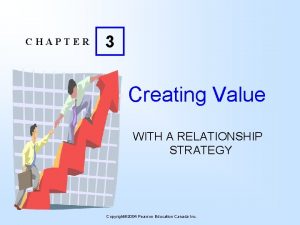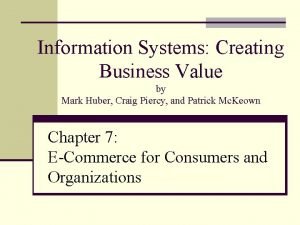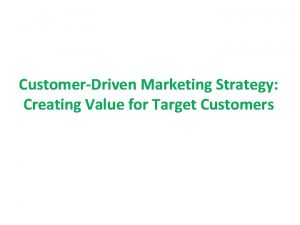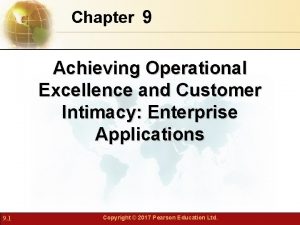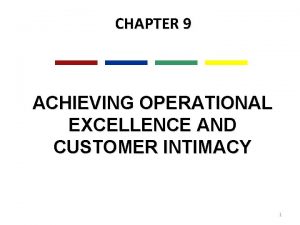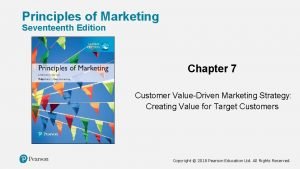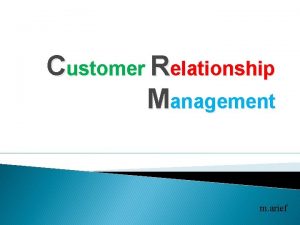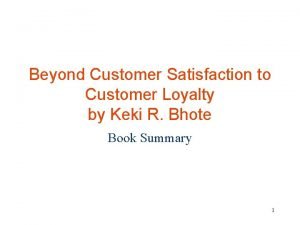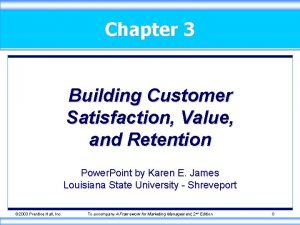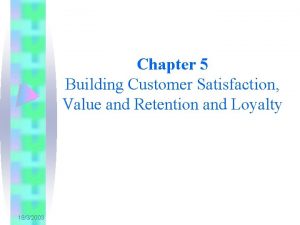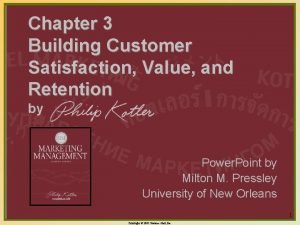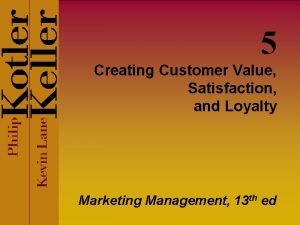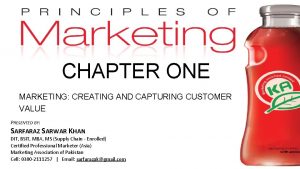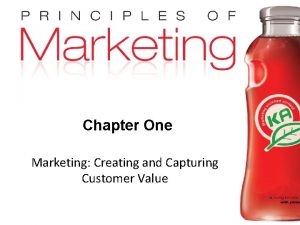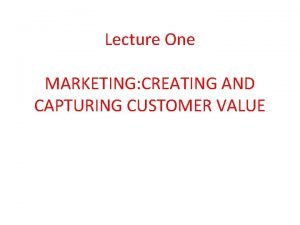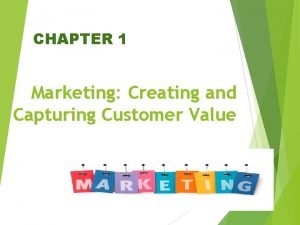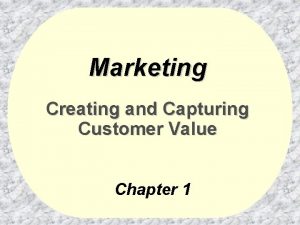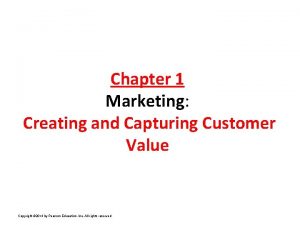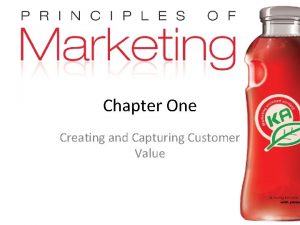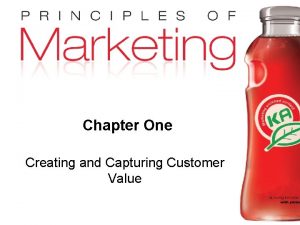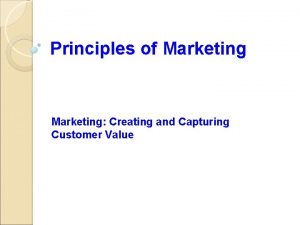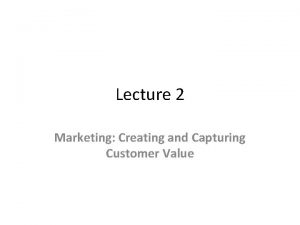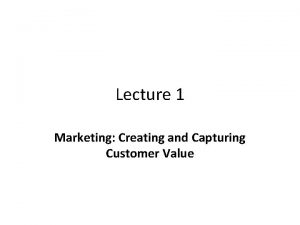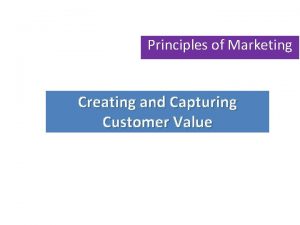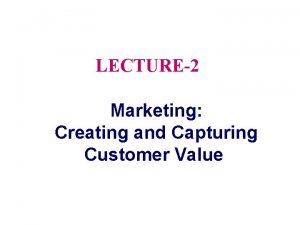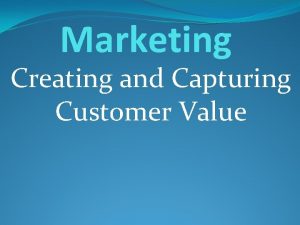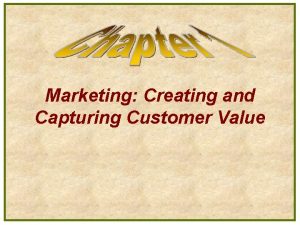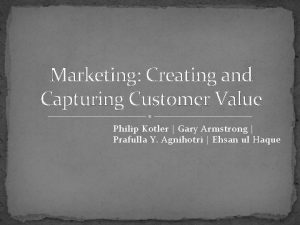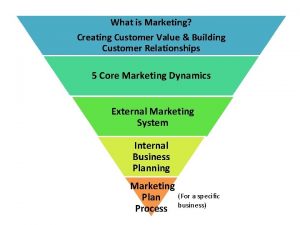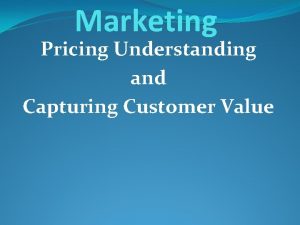Chapter One Marketing Creating and Capturing Customer Value









































- Slides: 41

Chapter One Marketing: Creating and Capturing Customer Value Copyright © 2009 Pearson Education, Inc. Publishing as Prentice Hall Chapter 1 - slide

Creating and Capturing Customer Value • • What Is Marketing? Understand the Marketplace and Customer Needs Designing a Customer-Driven Marketing Strategy Preparing an Integrated Marketing Plan and Program • Building Customer Relationships • Capturing Value from Customers • The Changing Marketing Landscape 1 -2 Topic Outline

Marketing is a process by which companies create value for customers and build strong customer relationships and in return, capture value from customers. 1 -3 What Is Marketing?

• • • 1 -4 Goods Services Places Ideas Events Persons Properties Organizations Information Experiences 1 -4 What Can Be Marketed?

What Is Marketing? 1 -5 The Five-Step Marketing Process

Step 1: Understanding the Marketplace and Customer Needs & Wants 1 -6 Core Concepts

Needs, Wants & Demands • A human need is a state of felt deprivation. v Social: belonging and affection v Individual: knowledge and self-expression • A want is the form a need takes as shaped by culture and personality • Demands are wants backed by buying power 1 -7 v Physical: food, clothing, warmth, safety

1 -8 This American Dairy Council campaign features Elizabeth Hurley and reminds the consumer of a need

Understanding the Marketplace and Customer Needs combination of products, services, information, and experiences offered to a market to satisfy a need or want • Marketing Myopia is focusing only on existing wants and losing sight of underlying consumer needs 1 -9 • Market Offerings are some

Understanding the Marketplace and Customer Needs Customers • Value and satisfaction Marketers • Set the right level of expectations • Not too high or low 1 - 10 Customer Value and Satisfaction Expectations

Understanding the Marketplace and Customer Needs from someone by offering something in return • Marketing consists of actions taken to build and maintain desirable exchange relationships with target audiences involving a product, service, idea, or other object v Attracting new customers and creating transactions v Retaining customers and growing their business with the company 1 - 11 • Exchange is the act of obtaining a desired object

Markets: The set of actual and potential buyers of a product Marketing System: All of the actors who are affected by environmental forces 1 - 12 Understanding the Marketplace and Customer Needs

Marketing Management is the art and science of choosing target markets and building profitable relationships with them v What customers will we serve? v How can we best serve these customers? v Creating, delivering and communicating superior customer value is key. 1 - 13 Step 2: Designing a Customer. Driven Marketing Strategy

Designing a Customer-Driven Marketing Strategy Market Segmentation refers to dividing the markets into segments of customers Target Marketing refers to which segments to go after 1 - 14 Selecting Customers to Serve

Designing a Customer-Driven Marketing Strategy Demarketing is marketing to reduce demand temporarily or permanently; the aim is not to destroy demand but to reduce or shift it 1 - 15 Selecting Customers to Serve

The Value Proposition is the set of benefits or values a company promises to deliver to customers to satisfy their needs 1 - 16 Designing a Customer-Driven Marketing Strategy

Designing a Customer-Driven Marketing Strategy 1 - 17 Marketing Management Orientations Production concept Product concept Selling concept Marketing concept Societal concept

Designing a Customer-Driven Marketing Strategy Production Concept: is the idea that consumers will favor products that are available or highly affordable. 1 - 18 Marketing Management Orientations

Designing a Customer-Driven Marketing Strategy Product Concept is the idea that consumers will favor products that offer the most quality, performance, and features. The organization should therefore be making continuous product improvements. 1 - 19 Marketing Management Orientations

Designing a Customer-Driven Marketing Strategy Selling Concept is the idea that consumers will not buy enough of the firm’s products unless it undertakes a large scale selling and promotion effort. 1 - 20 Marketing Management Orientations

Designing a Customer-Driven Marketing Strategy Marketing Concept is the idea that achieving organizational goals depends on knowing the needs and wants of the target markets and delivering the desired satisfactions better than competitors do. 1 - 21 Marketing Management Orientations

1 - 22 The Selling and Marketing Concepts Contrasted

Designing a Customer-Driven Marketing Strategy Societal Marketing Concept: A company should make good marketing decisions by considering v Consumers’ wants v Consumers’ long- term interests v Society’s long-run interests v Company’s requirements 1 - 23 Marketing Management Orientations

1 - 24 Designing a Customer-Driven Marketing Strategy

What Is Marketing? 1 - 25 The Five-Step Marketing Process

The Marketing Mix is the set of tools (four Ps) the firm uses to implement its marketing strategy. It includes product, price, promotion, and place. Integrated Marketing Program is a comprehensive plan that communicates and delivers the intended value to chosen customers. 1 - 26 Step 3: Preparing an Integrated Marketing Plan and Program

Step 4: Building Customer Relationships Customer Relationship Management (CRM) building and maintaining profitable customer relationships by delivering superior customer value and satisfaction. 1 - 27 • The process of

Building Customer Relationships Customer. Perceived Value • The difference between the values that the customer gains from owning & using a product and the costs of obtaining it. Customer Satisfaction • The extent to which a product’s perceived performance matches (or exceeds) a buyer’s expectations. 1 - 28 Relationship Building Blocks: Customer Value and Satisfaction

1 - 29 Trying to change the perceived value of Cheerios Cereal Bar by helping consumers evaluate its nutritional value

Building Customer Relationships Low Margin Customers: Basic Relationships Key Customers: Full Partnerships 1 - 30 Customer Management: Not All Customers are Equal, You Must Be Selective

Building Customer Relationships The Changing Nature of Customer Relationships customers uses selective relationship management to target fewer, more profitable customers • Relating more deeply and interactively by incorporating more interactive two way communication through blogs, Websites, online communities and social networks • Relating for the long term to retain current customers and build profitable, long-term relationships 1 - 31 • Relating with more carefully selected

Partner Relationship Management involves working closely with partners in other company departments and outside the company to jointly bring greater value to customers 1 - 32 Building Customer Relationships

Building Customer Relationships Partner Relationship Management function area interacting with customers • Partners outside the company are how marketers connect with their suppliers, channel partners, and competitors by developing partnerships 1 - 33 • Partners inside the company are in every

Building Customer Relationships Partner Relationship Management • Supply Chain is a channel that stretches from Raw Materials Components Final Products 1 - 34 raw materials to components to final products to final buyers v Supply management v Strategic partners v Strategic alliances Final Buyers

Step 5: Capturing Value from Customers Creating Customer Loyalty and Retention entire stream of purchases that the customer would make over a lifetime of patronage 1 - 35 • Customer Lifetime Value is the value of the

Customer Relationship Management Key Concepts • Attracting, retaining and growing customers • Building relationships and customer equity satisfaction § Created by meeting/ exceeding expectations § Perceptions are key • Loyalty and retention § Many benefits of loyalty § Increases as satisfaction levels increase § Delighting consumers should be the goal • Growing share of customer 1 - 36 • Customer value and

Capturing Value from Customers Share Of Customer is the portion of the customer’s purchasing that a company gets in its product categories v Cross-selling v Up-selling 1 - 37 Growing Share of Customer

Customer Equity is the total combined customer lifetime values of all of the company’s customers 1 - 38 Capturing Value from Customers

Customer Relationship Management • Attracting, retaining and growing customers • Building relationships and customer equity and tools § Customer loyalty and retention programs Ø Adding financial benefits Ø Adding social benefits Ø Adding structural ties § Selective customer management 1 - 39 Key Concepts • Customer relationship levels

The Changing Marketing Landscape • Digital Age: Major advances in computers, • Rapid Globalization: Geographical and cultural distances have shrunk (increased competition) • Ethics and Social Responsibility: Marketers must take greater responsibility for the impact of their actions • Not-for-Profit Marketing: Not-for-profit organizations are realizing the importance of strategic marketing (museums, hospitals, etc. ) 1 - 40 telecommunications & transportation

1 - 41 So, What Is Marketing?
 Marketing creating and capturing customer value
Marketing creating and capturing customer value Creating and capturing customer value
Creating and capturing customer value Creating and capturing customer value
Creating and capturing customer value Creating value and capturing value
Creating value and capturing value Marketing: creating customer value and engagement
Marketing: creating customer value and engagement Pricing: understanding and capturing customer value
Pricing: understanding and capturing customer value What is customer value satisfaction and loyalty
What is customer value satisfaction and loyalty Creating customer value satisfaction and loyalty
Creating customer value satisfaction and loyalty Creating customer value satisfaction and loyalty
Creating customer value satisfaction and loyalty Channel levels in marketing
Channel levels in marketing Qualitative research techniques to measure brand equity
Qualitative research techniques to measure brand equity Capturing customer mindset
Capturing customer mindset Kevin kotler net worth
Kevin kotler net worth Capturing marketing insights
Capturing marketing insights Swot analysis of sari sari store
Swot analysis of sari sari store Customer value driven marketing strategy
Customer value driven marketing strategy Marketing channel objectives
Marketing channel objectives Marketing channels delivering customer value
Marketing channels delivering customer value Multi channel distribution
Multi channel distribution Culture vs formalization
Culture vs formalization Creating a customer responsive culture
Creating a customer responsive culture Penciptaan nilai adalah
Penciptaan nilai adalah You are creating in prtu the value fund portfolio
You are creating in prtu the value fund portfolio Building relationships creating value
Building relationships creating value Creating business value through information technology
Creating business value through information technology Designing a customer driven marketing strategy
Designing a customer driven marketing strategy Customer relationship management and customer intimacy
Customer relationship management and customer intimacy Customer relationship management and customer intimacy
Customer relationship management and customer intimacy Intimacy
Intimacy Building and delivering customer value and satisfaction
Building and delivering customer value and satisfaction Structure of twelfth night
Structure of twelfth night Creating long term loyalty relationship
Creating long term loyalty relationship Principles of marketing chapter 7
Principles of marketing chapter 7 Analyzing and using marketing information
Analyzing and using marketing information Pengertian customer relation
Pengertian customer relation Beyond customer satisfaction
Beyond customer satisfaction Core customer value
Core customer value How to build customer satisfaction value and retention
How to build customer satisfaction value and retention Building customer satisfaction value and retention
Building customer satisfaction value and retention Customer satisfaction value and retention
Customer satisfaction value and retention What is customer value satisfaction and loyalty
What is customer value satisfaction and loyalty One empire one god one emperor
One empire one god one emperor
